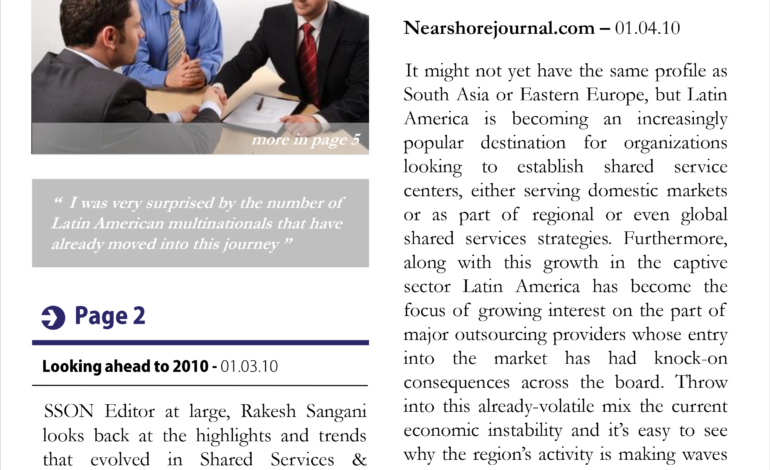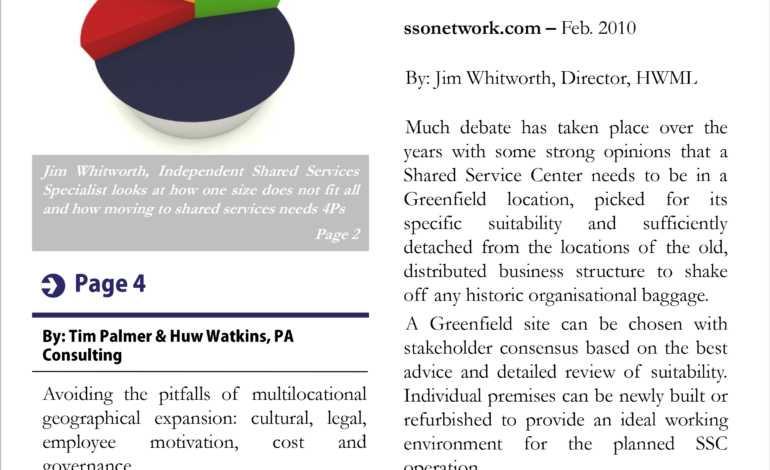news
Realização (E)
Uma empresa do grupo VISAGIO
MARCH, 10!" 2010
WEDNESDAY
GOVERNANÇA
Centro de
Serviços
Compartilhados
e
ja;
Ee
=
s
E
RE:
a
(ra)
o
pai
MODELO DE GESTÃO
|
Q Page 2
ssonetwork.com — Feb.2010
SSON Clinic has a panel of experts to
answer your shared services and
outsourcing questions, no matter how
new or mature you are. Phil Searle,
Founder and CEO, Chazey Partners gets
the ball rolling with a planning and
launching query.
) Page 3
decisionreport.com.br — 25.02.2010
YEAR 1 | Nº9
Top 10 Developments that
changed Shared Services...
ssonetwork.com — fev. 2010
By: Jamie Liddell, SSON
It's remarkable to think that the space in
which we operate - now a skein of
connected activities across numerous
industries and sectors employing millions
of people and involving many billions of
dollars - has only existed in anything like
its current form for a mere handful of
years. From concept to delivery, the
shared services and outsourcing space
has been granted a fraction of the
development time which more
established activities such as
manufacturing have enjoyed - but
nevertheless, in that time we've witnessed
some truly remarkable developments
which have utterly revolutionized the
business environment - and, indeed, the
very nature of business.
9 Page4
Jan.2010
Confita o resultado de um estudo com
40 empresas européias e indianas sobre
os “Doze Passos Pata o Sucesso do
Offshore Outsourcing”.
CCR e Vale foram as grandes vencedoras
do 1º Prêmio de Excelência em Centro
de Serviços Compartilhados, realizado
durante o Shared Services Brasil 2010.
�9 SSON Clinic: Chargeback
mechanism SSC
ssonetwork.com
February, 2010
SSON Clinic has a panel of experts to answer your shared
services and outsourcing questions, no matter how new or
mature you are. Phil Searle, Founder and CEO, Chazey
Partners gets the ball rolling with a planning and launching
query.
By: Phil Searie, Fonnder & CEO, Chazey Partners,
Question: I am looking for some credentials regarding
chargeback mechanism within a Shared Service centre. 1
know that there are quite a few options, like cost per
transaction, percentage of usage or cost-plus, but which
mechanism has been considered as best practice? It would be
great if you could add some credentials of these best
practices.
Phil Searle: Whether and how to use Chargebacks for
shared Services is a significant item for debate and
consideration for those planning to set up a new Shared
Services operation. 1 would add that this is also a significant
topic for existing and mature Shared Services operations as
well!
The aim of chargebacks is to implement a commercially
based pricing mechanism to support the provision of
services to the internal customer, just as would be the case if
the Shared Services operation were an independent,
commercial entity, Remember that the key difference
between Shared Services and traditional Corporate driven
centralization is the emphasis on the customer, and the
effective use of chargebacks can be a part of this.
Chargebacks are also often introduced to assist with
allocation of effort and resources and to help drive
behaviour, as it the case with independent “arms length”
pricing. It is also important to remember that the third party
outsourced service providers alteady do have independent
“arms length” pricing as they are commercially driven,
separated businesses in their own right.
So should chargebacks always be used and, if so, what are
the “best practice” methods of calculating chargebacks? In
fact there are many different way of calculating chatgebacks,
as highlighted in the question, tanging from simple high level
“allocations” (similar to traditional Corporate calculated type
of allocations) through to much more complex pricing,
based on service levels agreement levels, volumes,
exceptions, preferred technologies etc. Allocations
themselves can take a range of forms as well, from straight
one-for-one cost allocations to cost plus pricing and other
cost allocation based methods.
My advice is to keep it simple, especially early on, but do
determine when it is best to implement some form of
chargebacks and then when to make the method and
calculations more complex. In the early days of
implementing a new SSO don? get distracted by the desire
for complex pricing mechanisms as this could deflect you
from actually implementing effective service offerings under
the new SSO umbrella and could result in protracted and
unhelpful pricing “negotiations” with the
business. However, as things begin to settle down post
initial implementation and service provision becomes more
standardised and embedded, then consider implementing
more complex pricing mechanisms to help allocate resources
and drive internal customer behaviour for the benefit of all
concerned.
An example of more complex pricing would be to charge
based on a menu of services and transaction types (e.g.
manual invoice vs automated invoice, request for change to
inventory master, customer master or vendor master data,
processing of payroll by country /currency, etc). You could
also consider introduce penalty pricing where a much greater
fee is charged for “exception handling requests” from the
Operating units (e.g. for emergency cheque requests, rapid
response turnaround requests faster than stated in previously
agreed Service Level Agreements, processing of purchase
invoices without an approved PO, late entry of journals,
incorrect coding, improper use of communication channels
for making service requests etc). However, I would like to
reiterate that one of the main advantages of an inhouse SSC
over a third party BPO provider is that you can keep it
simple so don't get too complex too quickly.
You also need to ensure that you have the systems and tools
in place to actually track what you want to measure in order
to calculate periodic charges to the business (based on
whatever volumes and variables have been agreed to
calculate prices). You dont want to have to perform
complicated pricing calculations manually as this increases
workload and is of course also prone to manual error and
debate.
I would recommend when moving to commercial type
pricing to consider when the right time for this is and then
how to do it. In the early stages of implementations for
Shared Services you don't necessarily want the operating
units to be able to go outside of the internal SSO as they may
well chose to do this before you have had the chance to
eliminate inefficiencies (through standatdisation, automation,
etc). If this were to happen this would cause an ever greater
www.institutodegestao.com.br
�cost problem to the corporate through duplication of
ovetheads — internally and then with the third party BPO
providers sourced by the Operating Units themselves. So be
careful when deciding if, when and how to allow the
operating units to “go outside” to buy their own services. 1
would normally suggest at least 12 months after
implementation that operating units are NOT allowed to
seek alternative providers. And probably longer. Having said
this, ultimately if a SSO cant justify its costs and pricing
against alternatives (along with other critical considerations
around service and control) then the SSO is not performing
as well as it should and may have failed to deliver on its
promised. SSOs should not be “afraid” of competition and
should be transparent in its internal costing and pricing, even
if chargebacks or commercial based pricing are not used.
One could also consider going to commetcial pricing sooner
rather than later by “eating” any excess costs incurted by the
SSO within the SSO itself so that the Operating Units feel
the benefits of commercial pricing sooner. Then the SSO
would have to work out how to quickly achieve efficiencies
to eliminate any excess of costs over recoveries from the
operational unit pricing so that the whole Corporation
benefits from teduced cost to service from Shared
Services. This “commercially based” pricing could be based
on best practice benchmarks considered relevant and
appropriate to the scale and complexity of your business.
So, in summary:
* Chargebacks can be a significant enabler for effective
shared services
* But timing and complexity considerations ate critical
* Consider keeping them very simple early on and only make
them more complex once you are more stable
* Leverage them to help allocate resources and reduce costs
by “rewarding” the following of agreed, standards processes
and penalising exception processing
* Make sure that you have or can introduce systems and
tools (preferably leveraging your ERP platform where
possible) to calculate and track your chargebacks
3) Doze passos para o
sucesso do offshore
outsourcing
decisionreport.com.br
February 25%, 2010
A Quint, consultoria holandesa especializada em
gerenciamento de serviços, governança e melhoria do
desempenho de TI, realizou um estudo com 40 empresas
européias e indianas sobre os “Doze Passos Para o
Sucesso do Offshore Outsourcing”. Mais da metade das
empresas disse que terceiriza sem saber o que tem dentro
do ambiente de TI. “Embora a pesquisa tenha sido
realizada fora do Brasil, essa realidade é bastante comum
em países da América Latina”, observa Ulysses Pacheco,
country manager da empresa para o Brasil e México.
Ele explica que a AL tem dificuldade em documentar os
seus processos, o que dificulta saber o que terceirizar e o
que a empresa quer. “À questão é quais os fatores que o
CIO quer medir, antecipar e onde ele terá problema. E,
ainda, se houver problema, o que fazer”, diz Pacheco que
completa: “a maior parte dos executivos se preocupam
com a duração do contrato e níveis de SLA não são bem
escritos justamente porque não sabem o que necessitam
com precisão”.
A partir daí, o fornecedor entrega justamente aquilo que o
cliente. Do lado do usuário, isso gera descontentamento.
Portanto, existe uma discrepância e dificuldade em mapear
as necessidades do negócio e cruzar essas informações
com o que o fornecedor oferece.
A área de informática, segundo Pacheco, está preocupada
com o parâmetro dela, como disponibilidade e
performance e não olha os indicadores de negócio. Das 43
empresas ouvidas, somente 18 olham para isso. “Apesar
disso, o Brasil começa a ser mais exigente em serviços de
segundo nível. Na avaliação de Pacheco, as grandes
multinacionais são mais maduras porque a exigência é
global”.
Por isso, pata ele, o cloud computing não é uma tealidade,
uma vez que ainda existe uma grande dificuldade em saber
o que terceirizar e como cobrar os serviços do fornecedor.
Saiba os doze passos para alcançar o sucesso do offshore
outsourcing:
“Crie um relacionamento entre empresa e fornecedor de
alta qualidade;
“Saiba administrar os requisitos e mudanças;
“Estabeleça a estrutura correta de governança de sourcing;
“Administre as diferenças culturais;
*Comunique-se da melhor maneira possível;
*Alinhe os processos de entrega;
“Administre a transferência de conhecimento;
“Defina o contrato corretamente, com riqueza de detalhes;
“Aproxime-se do sourcing offshore estrategicamente;
“Selecione cuidadosamente os fornecedores de serviços;
“Administre de perto a performance do offshore de
sourcing;
*Seja seletivo no que diz respeito ao offshore.
www.institutodegestao.com.br
�9 CCR Vale são destaque
em premiação inédita no
Brasil
Janeiro de 2010
CCR e Vale foram as grandes vencedoras do 1º Prêmio de
Excelência em Centro de Serviços Compartilhados, realizado
durante o Shared Services Brasil 2010. O evento, organizado
pelo IQPC, aconteceu de 19 a 21 de janeiro e contou com a
premiação inédita, que elegeu os melhores CSCs em duas
categorias: Best New (CSCs com menos de 3 anos) e Best
Mature (CSCs com mais de 3 anos).
O Prêmio de Excelência em Centro de Serviços
Compartilhados é realizado pelo IQPC nos EUA e na
Europa há alguns anos. O prêmio chegou este ano ao Brasil
com o objetivo de reconhecer e promover os CSCs que
demonstrem as melhores práticas.
FINALISTAS:
Categoria Best New: Robert Bosch, Vale, Estácio de Sá
Categoria Best Mature: Actua (Grupo CCR), AmBev,
Camargo Correa e Oi
VENCEDORES:
Best New: VALE
Best Mature: ACTUA (Grupo CCR)
9 Top 10 Developments that
changed Shared Services
ssonetwotk.com
February, 2010
Our contributors look back on the key developments which
made the space what it is today...
By: Jamie Liddell, SSON,
T?s remarkable to think that the space in which we operate -
now a skein of connected activities across numerous
industries and sectors employing millions of people and
involving many billions of dollars - has only existed in
anything like its current form for a mere handful of years.
From concept to delivery, the shared services and
outsourcing space has been granted a fraction of the
development time which more established activities such
as manufacturing have enjoyed - but nevertheless, in that
time we've witnessed some truly remarkable developments
which have utterly revolutionized the business
environment - and, indeed, the very nature of business.
Às Ed Kirkby, Senior Consultant at EquaTerra, recalls:
“Having been involved in the IT industty since 1983 I
have seen many changes - and much re-inventing of the
wheel. Apart from the technology drivers and the advent
of offshore (e.g. India) there are other developments over
this period of: one-stop shop versus selective outsoutcing
(best in class), new business models (ASPs/ISPs and
Legacy), Business Process Outsourcing, complexity and
future proofing considerations, more sophisticated
financial engineering, partnerships and joint ventures,
commoditization of “me too” deals in mature markets as
well as Sole-Source versus Competitive Tender. These
have all combined to make outsourcing one of the most
interesting market sectors to be in, both from a historical
perspective and the place to be in the future — why?
Because outsourcing works!”
Recently SSON reached out to a number of experts and
commentators from around the shared services and
outsourcing space to give their thoughts on the
developments which have made the space what it is today.
Now, we present the result: our Top Ten Developments
Which Changed Shared Services & Outsourcing. Enjoyl
1. Technological advances
No surprises that this one's on the list; pretty much every
one of our contributors mentioned technology in one
form or another, whether it be the incredible facilitating
impact of the internet or the development of specifically
process-related tools boosting companies” efficiencies and
productivity. I?s impossible to imagine life today without
many of the technological innovations which have taken
place, or reached maturity, during the period of time in
which the shared services and outsourcing space has
blossomed and boomed; it's even less possible to imagine
that space without the technology upon which it is
supported.
Às The Hackett Group's Tom Bangemann says: “the one
big enabler is technology, because without technology
developments - especially ERP 20 years ago - no global
business service or shared service organization of any sort
would work.”
www.institutodegestao.com.br
�2. Globalization
Alongside purely technological advances, of course, must be
placed the dramatic changes in the relationships between
nations and individuals, and the contracting or removal of
previously obstructive chasms between locations and
businesses, which have become known as globalization. It is
possible to conceive of a form of shared service, and a
variety of outsourcing, emerging in a non-globalized
environment - but it's absolutely impossible to see how
either of those two concepts could ever have reached the
levels of complexity, or resulted in the remarkable gains in
efficiency and effectiveness, which they have achieved thanks
to what journalist and academic Frances Cairncross has so
elegantly termed “the death of distance”.
“The key development that makes shated services and
outsourcing the successful model it is today is globalization)”
says CenterPoint Energy's Julienne Sugarek. “Through
technology, we can be connected instantly to people in other
cities, states and countries. We can pass work products back
and forth as if our offices were down the hall from one
another. In addition, the promotion of free trade has led to
reduced transportation costs and the harmonization of
intellectual property laws has opened the doors to a new way
of doing business - business without borders.”
The Hackett Groups Tom Bangemann concurs: “There are
today tens, possibly hundreds of locations able to provide
GBS services. The supply side is also bolstered by the growth
of the BPO and ITO industries. Without adeguate supply the
can be no match between supply and demand! Globalization
has also led to organizations taking a more business and less
local or nationalistic view on labor issues, hence the
willingness to deploy GBS SDM has increased and today
almost all medium and large organizations use this SDM (to
some extent).”
3. The development of outsourcing as a distinct
profession
Às outsoutcing first touched upon, then burst into, the
economic and corporate mainstream, it of necessity became
an activity which required increasing specialization and
particularization on the part of those engaged within it.
Whereas at the beginning of the outsourcing boom
developments were being driven by experts in other fields
who wete able to envision how tadically outsourcing would
impact upon business practice, today's outsourcing
practitioners are finely-tuned specialist professionals (you
know who you are...) with an understanding of their
environment immeasurably broader and deeper than that of
those first pioneers.
“There was a time when professionals with general
transaction skills were the primary architects of outsourcing
transactions, and buyers typicaliy engaged in shared services
outsourcing relationships with limited or no specialized
expertise. Over the past 10 years, outsourcing
“There was a time when professionals with general
transaction skills were the primary architects of
outsourcing transactions, and buyers typically engaged in
shared services and outsourcing relationships with limited
or no specialized expertise. Over the past 10 years,
outsourcing advisory has grown into a distinct
specialization for lawyers, consultants and procurement
professionals. A host of certifications have also been
created to validate this specialization. The specialization of
these intermediaries has led to increased competitiveness
and standardized industry transaction practices,” maintains
Robin Rasmussen, Director, Shared Services &
Outsourcing Advisory at KPMG.
4. The rise of value-adding finance roles
Just as the development of outsourcing has required the
development of outsourcing specialists, so too changes in
the nature of the finance function (with the evolution of
shared services a notable contributory factor) have
required the emergence of a new set of roles within
finance - a development which is still very much ongoing.
The requirement for added value, and the response of
businesses to changes in the nature of businesses
themselves, have created a new generation of
professionals with remits often far beyond those of their
predecessors, wrestling with challenges which previously
might not have existed, ot might at least have been
considered to reside well outside the responsibilities of
finance teams.
“Perhaps more “work in progress” than completed
development, the growth of value-adding finance roles
outside both the traditional finance department and the
shared service arena has certainly changed the culture
within which SSO and BPO programs are implemented,”
believes independent finance and shared services expert
Jim Whitworth. “Early shared services had to fight their
way through considerable resistance, often from finance
management who sought to protect the traditional
departmental structure and roles that had shaped their
careers to date and had been expected to continue to do
so. Businesses fuelled the conflict by failing to get to grips
with building and executing a vision for the contribution
that finance professionals could continue to make outside
the newly acquired SSC or outsource partnership.”
Whitworth continues: “Fortunately, we're now seeing
many more alternatives for finance careers outside the
Manager — Controller — Director route in a traditionally
structured finance organization. Developing systems and
processes in a technically complex world, ensuring
compliance and controls to meet ever-increasing
www.institutodegestao.com.br
�regulation and partnering business leaders in decision
making have all become careers in their own right in
recent years. As this greater range of options continues to
develop, the shared services practitioner may no longer be
the enemy threatening the finance management status quo
but the key to futute opportunity. Greater support brings
faster implementation, easier stabilization and stronger
sustainability as those retained from the old organization
focus on new toles that challenge and add value.”
5. The rise (and fall) of the mega-deal
Is an old lesson in business as well as in math that the
numbers just keep getting bigger over time (even if your
own shate of them seems to shrink by the day...). Once
outsourcing built up a full head of steam, and companies
got to grips with the advantages and attendant risks (and
how to manage them) associated with the practice, it was
only a matter of time that the deals taking place grew to
occasionally jaw-dropping scale. Of course, that created a
whole new tealm of risk...
“The “mega-deal” not only helped the outsourcing industry
address the needs of large, multi-national companies, but
it also elevated outsourcing decisions to the highest levels
of the buyer organization, which in turn helped establish
outsoutcing as a permanent option for operations strategy.
Ironically, the “mega-deal” also exposed some of the
limitations of the outsourcing business model, as it
magnified the impact of execution and governance
failures. Service providers, buyers and their advisors
continue to look for ways to address the limitations and
risks exposed by the mega-deal,)” says Eugene Kublanov,
Director, Shated Services and Outsourcing Advisory at
KPMG.
6. Best-practice vision for support functions
Some of the developments that have contributed to the
evolution of shared services and outsourcing have been
very tangible - technological advances being a case in
point. Others, however, have been extremely abstract -
and an example of this is the emergence of the concept of
best practice within support functions. Abstract or not,
however, the impact of this concept has been all but the
idea that support functions - particularly within finance -
could be optimized and made efficient in the same way as
an assembly line or a supply chain has tevolutionized the
back office and helped drive some of the most important
advances in business practice in living memory.
“Shared services started in the mid 1980s in finance
functions with some enterprising US-based corporations
who took a look at finance costs as a percentage of
revenue, realized they had a full accounting function in
every manufacturing plant or depot, and thought they
could halve the cost or better by co-locating it)” explains
Philip King of Atos Consulting. “The name “shared
services” was invented to make it more palatable to
concerned stakeholders. It was putely a cost-reduction
play at the time. And to some degree this is still
paramount - but, as most people who reads these pages
know, there is more to it than that. The words “shated
services” now have real meaning: shared resources, shared
responsibility and real customer service provision.
However the real added value ftom shated services is
realized when it is an integral and fundamental part of a
functional transformation preferably aligned to business
strategy or transformation. And this is applicable to any
support function — e.g. Finance, Procurement, HR, IT,
Facilities & Estates, Customer Management/Setvice.
“One of the key developments that have sustained and
enhanced the role of shared services is the development of
the best-practice vision for support functions. This can be
traced back to consulting firms in the 1990s that began to
spread the gospel of “the future of finance with a best
practice organizational architecture including corporate
“centers of excellence/expertise', “business partners*, and
“shared services” - the three key functional sub-divisions of
an optimal support function organization. This has since
been applied to all support functions — the terminology
might be slightly different, but the principle is the same.
Focusing the right activities in each atea and aligning the
appropriate resources multiplies the benefits: e.g. shared
services support the business partner role by taking away
the distractions of routine transaction processing and
providing consistent data. The organization will benefit
from the strategic value the business partner can provide if
the right type of resource is deployed and the objectives of
the role ate clear.
“Done well all three parts of this support function vision
are complementary and the value of change is multiplied.
If done poorly this leads to a lack of clarity and belief in
the shared services idea, as the full benefits are not
realized. The terminology differs slightly from one
function to another, but the concept is proven. Many
organizations still have not fully grasped this fundamental
vision, but it is even mote important in the current so for
those who have not yet picked up on this key
development, Pd urge you to work at it”
7. Increased buyer savvy
Outsourcing providers might be tempted to provide just a
minimum satisfactory level of service (well, it's human
nature, maybe) but even if that weren't a rather short-
termist proposition, in today's outsourcing environment
it's tantamount to commercial suicide, A major reason for
this - alongside the proliferation of competing providers
eager to snatch away every unsecured morsel of trade - is
the increased savvy among buyers of outsourced services.
As the industry has matuted, so too has buyers”
understanding of what exactly can be gained - and at what
cost - from the various providers offering their services.
www.institutodegestao.com.br
�“Outsourcing and shated services are now central to
enterprise strategy and higher up the value chain, with
most businesses having invested in new skills and
reorganized themselves to identify optimum sourcing
strategies, execute deals and govern the new service
models. Whilst we still have further to go before sourcing
can be thought of as a truly mature industry the trend is
increasingly for more educated buyers, investing in new
capabilities and expecting more from providers who in
turn are maturing, consolidating and specializing to meet
increased client expectations. These factors taken together
have changed our view of what can be successfully
externalized or optimized to include value and knowledge
based requirements as well as commoditized services,”
says Tony Rawlinson, Managing Director, Financial
Services Advisory, Europe & Asia Pacific for EquaTerra.
8. The rise of India (and the rest)
“Outsourcing” might be excessively closely linked with
“India” in the minds of many consumers in the developed
world but there's a reason why that link was forged in the
first place. India has been the powerhouse of the offshore
outsourcing boom: its hyperpotent combination of
technological prowess, well-educated and -skilled
employees and that allimportant labor arbitrage has
propelled the sub-continent to the very forefront of this
dynamic space, resulting in vast gains for the Indian
economy - and for many companies worldwide whove
taken advantage of this incredible boom.
“The unmatched ability of top tier India-based
outsourcets to recruit, train, hire and onboard hundreds of
thousands of people each year established the offshore
delivery center as a viable service delivery model for
services providers. It also established a new competitive
segment of outsoutcing service providers that did not
otiginate in the U.S. or Western Europe. This in turn led
to new entrants not only from India, but from various
other developing countries that began to compete with the
top tier, multi-national service providers,” asserts Eugene
Kublanov of KPMG.
9. Changes in the accountancy environment
Of course outsourcing and shared services aren't just
about finance - but a significant proportion of activity
within the space remains driven by the finance function,
and a proporton of that drive comes from the
developments within the global accountancy environment
which have had such an impact on business within and
beyond shared services and outsourcing in recent years.
Sarbanes-Oxzley and similar regulatory efforts have created
new tealms of complexity which businesses have had no
choice but to address - and shated services has become
both a useful tool to address this, and profoundly affected
by the very changes which new legislation has driven.
“The evolution of the accountancy space over the past
couple of decades has really provided a huge driver for
many of the developments we've seen in back-office
structures and the outsourcing profession,” says
independent finance professional Keith Osborne. “Added
complexity in terms of compliance frameworks - not to
mention the increased severity of sanctions for those
failing to comply - has driven compliance up the corporate
agenda and created an opportunity for shared services to
become centers of accounting excellence, alongside the
need to keep down costs during this leap in complexity.
And of course several of the leading accountancy firms
have been at the forefront of the outsourcing and shared
service revolution in an advisory capacity as well as
transforming their own businesses...”
10. Governments” acknowledgement of outsourcing's
influence on the economy
The impact of the outsourcing boom on the Indian
economy was mentioned above - but of course it isn't just
India that has enjoyed the fruits - and had to deal with the
issues arising from - the globalization of outsourcing. Both
provider locations and governments of countries from
which work is being outsourced have had to face up to the
ways in which outsourcing impacts upon local and
national economies, and international trading
relationships. Policy must now encompass the economic
realities which outsourcing has forced upon pretty much
every countty on eatth - giving rise to many challenges to
which the solutions have not yet been found.
“Various governments in the developing world (India is a
salient example) have acknowledged the shared services
and outsourcing sector as a substantial and positive
influence on their economy. That acknowledgment has led
to policies which encourage human capital development,
and the modernization of infrastructure and commercial
regulation. This in turn has facilitated the globalization of
the shared services and outsourcing sector beyond its
geographic origins,” believes KPMG's Matamba Austin.
Rodrigo Lang
Vanessa Saavedra
Caio Fiuza
Eduardo Saggioro
Vitor Marques
www.institutodegestao.com.br
�
Shared Services News | Edição 09
Posts relacionados
Até 2017, previsão é que pelo menos 73% dos Centros passem
Pressão pela produtividade tem levado diretores e gestores de CSCs a
Atividades de TI como atendimento ao usuário, operação de sistemas e












